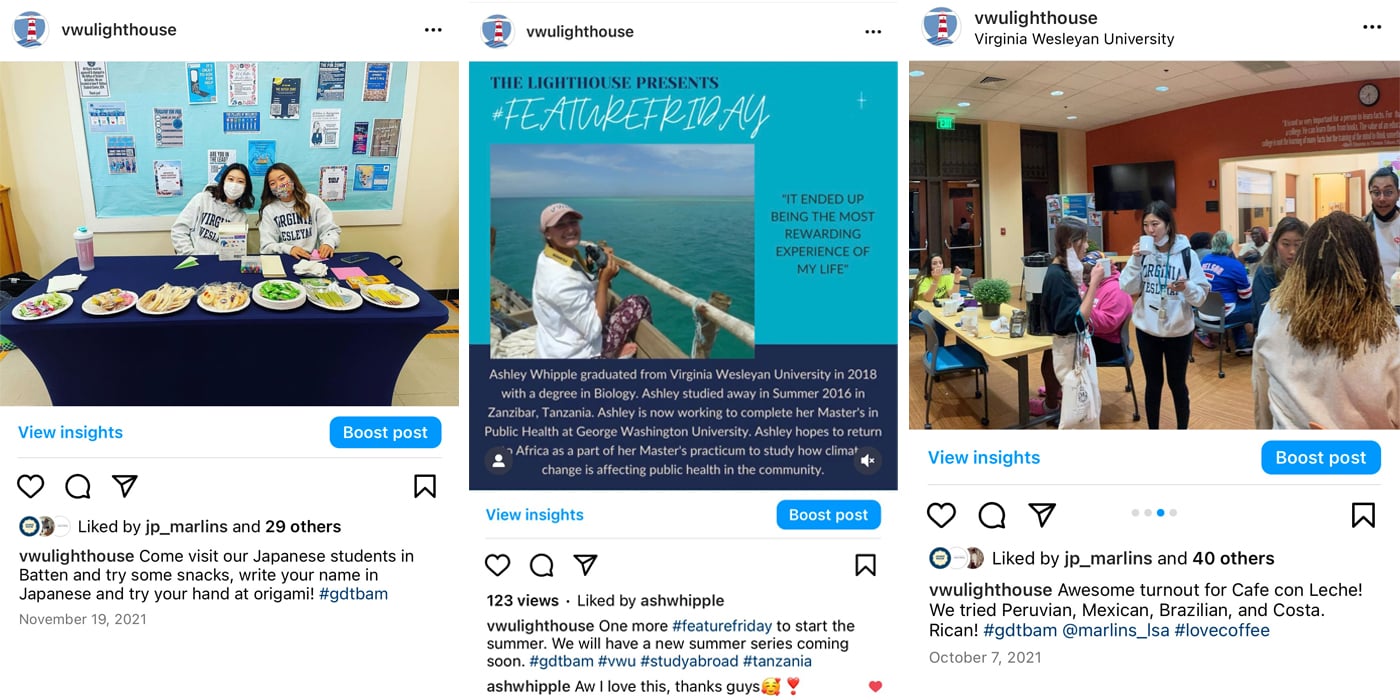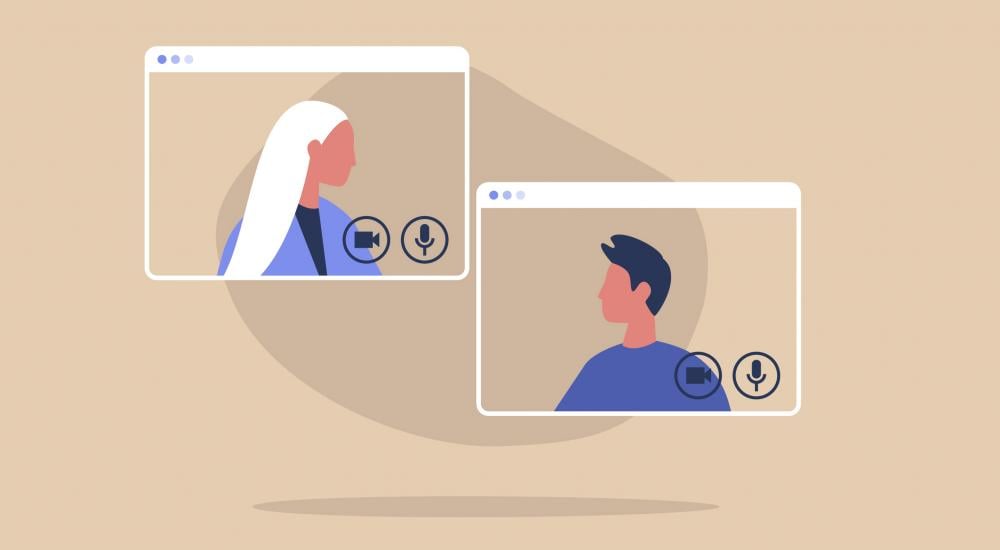Beyond Study Abroad Fairs: Recruiting in a Changed World

It’s a familiar sight on campuses across the United States, especially at the beginning of each semester or quarter: tables laden with brochures and displays advertising study abroad opportunities from Spain to Singapore. Study abroad fairs have long been a reliable staple for attracting students at higher education institutions to education abroad programs. But for many institutions these days, fairs alone aren’t enough to reach students. Pandemic-related changes to virtual events and efforts, plus shifts in student engagement, have caused education abroad offices to rethink and refocus their recruitment efforts.
From social media takeovers to developing new faculty relationships, seven education abroad professionals share how they’ve successfully moved beyond study abroad fairs.
Make the Experience Foundational
Emerging from the pandemic, study abroad fairs are being replaced by other efforts at Western Michigan University (WMU), most notably collaborations and partnerships with other institutional entities, says Joe Milostan, WMU’s director of study abroad and faculty enrichment.
“The pandemic forced us to take a hard look at all of our recruitment efforts and figure out which ones worked, which ones didn't, and why,” Milostan says. “In 2022, we took a critical look at the staff time and resources that we had been dedicating to our large, in-person study abroad fair.”
The office determined that the event didn’t convert student interest to program yield, so they’re redirecting those efforts toward other recruitment tactics, including building a foundational emphasis on study abroad as a key component of undergraduate education at WMU. Milostan hopes that will create an institutional pipeline to study abroad recruitment.
“Presenting study abroad to WMU students as an integral part of their academic, professional, and personal development can only be done through the voices of the individuals on campus who lead those efforts,” Milostan says. “Our goal is to present study abroad as an integrated experience, not as an extracurricular activity for those with interest and extra time.”
Backing this effort is an initiative that will subsidize students’ study abroad costs. In fall 2021, WMU launched a Global Engagement Program that required students to take two globally themed courses in innovative classrooms during their first year: a global classroom format and a virtual study abroad format. Participating carries no program fee and earns students a $500 scholarship to study abroad in a program of their choosing in the future, Milostan says.
Involve Faculty in Strategic Efforts
Faculty are important sources of recruitment, given the position of influence and trust they have with students.
At Kirkwood Community College (KCC), marketing campaigns to reaching faculty are the next priority after those that focus on students, says Dawn Wood, dean of global learning. “Faculty have the greatest influence over student decisions,” Wood says. Faculty outreach can be particularly important for community colleges, as many focus on shorter term, faculty-led mobility programs, Wood notes. “Faculty are our partners in the recruitment efforts and we make an individualized recruitment plan with them for each individual program, targeting the students that are the most likely to engage.”
“I have found classroom presentations are highly effective because the faculty member usually demonstrates their support, students can put a face to a name, and you have a captive audience,” says Mandy Reinig, director of global engagement at Virginia Wesleyan University (VWU). As the pandemic has eased, this technique has regained its importance as her access to classrooms has increased, Reinig says.
Emphasize Social Media
Many institutions have found success using social media to boost study abroad recruitment. Already one of the most important channels to connect with students, social media only increased in relevance during the pandemic, says Kelly Holland, vice president, institutional partnerships at study international education provider AIFS Abroad.
“Social media has long been a primary avenue to reach students, but its importance became elevated as program alumni graduated and campuses sat empty during the height of the pandemic,” Holland says.
“Our social media accounts are directed at prospective students, and we showcase student experiences in Instagram takeovers,” she says—where students are temporarily allowed full or partial control of an institution’s social media channel to share study abroad details—and “we share blog posts, and other details in a fun and informative way.”
At Siena College, a small liberal arts college in Loudonville, N.Y., social media initiatives are supplanting study abroad fairs as a primary source of recruitment, says Matt Schiesel, associate director of study abroad and international fellowships.
Still, not just any social media campaign will make an impact anymore, Schiesel and others say; staff put significant effort into keeping up with new features, trends, and platforms. Student workers can be a valuable resource for upping the social media game.
For example, Schiesel says, “as Instagram’s features continued to expand, we dived into Instastories (takeovers, polls, questions), story highlights, and IGTV series (short videos focusing on the application process, program opportunities, funding).”
“A video is worth a thousand words,” says Wood. They have been effective recruitment tools for KCC students. “Students love videos and like to see students who have participated before talk about their experience. It is important to feature diverse students in the videos with a vast array of backgrounds and experiences so students can envision themselves taking the step to study abroad.”
Move from Print to Digital
Websites and other online materials have replaced printed brochures and guidebooks as the dominant form of conveying authoritative university and college content about study abroad. Digital resources are less expensive to produce, can be updated more rapidly, and are more easily organized.
“We rely a lot on our website,” says Ben McKelfresh, who is a marketing coordinator and study abroad adviser at Iowa State University of Science and Technology and co-chair of NAFSA’s Marketing and Communications Member Interest Group. “And so we certainly try and drive students to our website as much as we can.”
“When I first started at Iowa State 7 years ago, we had a printed brochure for every single location or country.” McKelfresh says. “Now we’re down to one location brochure and all the [other] details on different locations are on the website. That allowed us to save a lot of time and money.”
Rethink Events
Though old-school study abroad fairs may be less favored, some study abroad offices report success with other in-person and hybrid activities.
Among the more traditional approaches that remain effective is “tabling,” which features study abroad staff or alumni sitting at a table in a frequently trafficked area.
“Tabling works well because we try and time it to when there will be the most student activity in the student center,” VWU’s Reinig says. “It also works best when we theme it and provide an activity, such as Japanese name writing, and try to get current study abroad students to encourage their friends to come. Tabling is relatively easy to put together, too.”
Western Washington University (WWU) has turned to events that are more flexible and fun than past study abroad fairs, says Krista Mantello, program manager of education abroad at WWU. In 2021, Mantello’s office launched EdAbroadCon!, an event that is offered both live and as recorded session.
“The EdAbroadCon! website was much easier to navigate and less overwhelming for students than a large, noisy room with over 60 tables of providers at our typical [fair],” Mantello says. “We were able to offer over 30 different types of sessions focusing on various majors, areas of study, locations, and global issues.”
Another bonus of taking the event online, she says, was “more concrete follow up with participants due to increase analytics on the website and a web form that for students to enter their interests and contact information. This translated to retention and an increase in social media followers and website traffic.”
Coordinate Actions to Amplify Efforts
Ideally, different marketing tools should relate to and reinforce each other, AIFS Abroad’s Holland says.
“Successful campaigns are tied together by topics and across platforms,” Holland says. “Say for example we’re spotlighting the AIFS Abroad Green Initiative, which is our plan to be carbon neutral by 2025. For example, AIFS has offset 78 tons of carbon for 2021 from international flights for AIFS abroad participants. Across platforms like Instagram, Linkedin, blog posts, and emails, the topic will be shared, repeated, and emphasized over a period.”
It is worth keeping in mind that optimal approaches at different institutions can vary.
For example, at Iowa State, study abroad fairs each semester continue to be a major part of the marketing approach and were restored after the initial pandemic lockdown as early as September 2020, even though actual study abroad programs did not restart until fall 2021, McKelfresh says.
No matter the size of the office, in the current social media-saturated, resource-constrained, postpandemic environment, institutions are prioritizing and streamlining efforts for maximum impact. Though the new generation of students responds differently to traditional study abroad fairs and marketing tools, administrators can still make the most out of their existing professional relationships and former students’ storytelling. The mediums of communication may have changed, but the messaging remains largely the same.
One-Person Offices: A Special Consideration
One-person international offices face particular time and cost challenges in their study abroad marketing, which makes prioritizing effective marketing channels essential.
“More than anything, it is more about budgeting my time to fit everything in between classroom presentations, overseeing social media, and my other duties,” says Reinig, the only study abroad staff member at VWU. “Most of what I do has little to no cost. I do have a budget for office supplies and for programming. This is a budget for the entire year and needs to include all events including events for international students. I do have to think about the costs which is why I look to lower cost activities first.”
Social media in particular can present challenges for a one-person office, she says. “As a one-person office I need to prioritize my tasks and sometimes social media gets put lower on that list. However, with a great student worker this makes scheduling social media posts easier and they are generally our target audience,” Reinig says.
Wood at KCC suggests one-person offices leverage alumni students and student workers. “Students have the best ideas for how to reach students,” she says. “Staffing is the number one cost, so utilizing students helps spread the work to others who have new and innovative ideas.”
NAFSA Resources
- NAFSA’s Guide to Education Abroad, 5th Edition, “Marketing in Education Abroad” chapter
- Facilitating Education Abroad: Blueprints for Successful Advising, “Creating Outreach and Marketing Campaigns” chapter
- NAFSA Member Interest Groups (MIGs) are online communities with discussion forums, events, and shared resources. MIGs are open to all.
About International Educator
International Educator is NAFSA’s flagship publication and has been published continually since 1990. As a record of the association and the field of international education, IE includes articles on a variety of topics, trends, and issues facing NAFSA members and their work.
From in-depth features to interviews with thought leaders and columns tailored to NAFSA’s knowledge communities, IE provides must-read context and analysis to those working around the globe to advance international education and exchange.
About NAFSA
NAFSA: Association of International Educators is the world's largest nonprofit association dedicated to international education and exchange. NAFSA serves the needs of more than 10,000 members and international educators worldwide at more than 3,500 institutions, in over 150 countries.
NAFSA membership provides you with unmatched access to best-in-class programs, critical updates, and resources to professionalize your practice. Members gain unrivaled opportunities to partner with experienced international education leaders.















